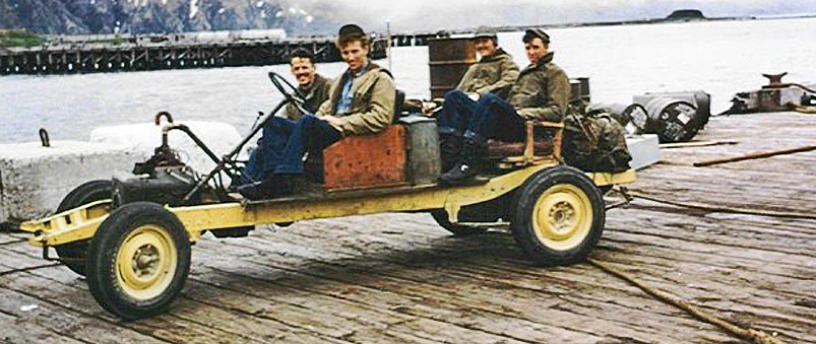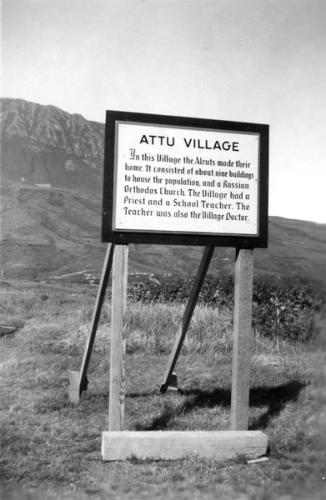


Originally published 22 June 2001

Photo Courtesty of Hal Tenney
ATTU, POST-WWII

These pages present photos and stories supplied by those either stationed on or visiting Attu
during the Post-WWII years. The WWII battle to wrest control of Attu from the Japanese
occupiers began on 11 May, 1943, and ended with Attu subsequently being secured by the
30th of May, 1943. The Casco Cove Coast Guard Station, otherwise known as LORAN Station
Attu, was established as a Naval Air Facility on 7 June 1943, seven days after Attu Island had
been declared secured. The United States maintained a contingency of Coast Guard troops
on the Island, whose primary responsibility was to maintain the LORAN-C navigational
equipment, until Attu closed on 27 August 2010.
The large encampment of allied military and other support personnel began to evacuate the
Aleutian Islands after the "hot" war ended in 1945, leaving only a small contingency of troops
behind to guard that for which a very high price had been paid in terms of human misery and
death by both the Japanese and American soldiers.
New threats began to emerge from a new enemy, Russia, a one-time American ally during
WWII, the result of conflicting ideological and governing methodologies. Russia further
devolved into Communism, while America maintained democracy and Capitalism as the
underpinnings of its society. America’s foreign policy towards Russia was formulated into
one of global containment. With the emergence of the "cold" war by 1947 new roles were
being defined for the Aleutian Islands as a part of those containment efforts, the foremost of
which was not only maintaining the security of America’s far-reaching, albeit remote, Aleutian
islands and the safety of their peoples…but also that of the north American continent over a
thousand miles further towards the east and beyond.
Russia’s primary threat emerged in the 1960s with the evolution of ICBM missile technology
and their nuclear warheads that could be carried towards America’s shores, coupled with
their newly developed anti-ballistic-missile (ABM) defense systems designed to counter
America’s growing arsenal of offensive ICBMs. Requirements were now mandated to keep an
eye on Russia’s progress along those lines, as well as to provide early warnings of a potential
launch of lethal missiles headed towards America. To minimize the arms escalation by both
sides, the SALT I treaty was signed in 1972, followed by the 1974 efforts to put SALT II in
place.
The AN/FPS-108 radar installation, otherwise known as “Cobra Dane,” was built on Shemya,
Aleutian Islands, AK in 1976, and brought on-line in 1977. It’s primary mission was that of
intelligence gathering in support of verification of the SALT II arms limitation treaty by
monitoring Russia’s Kamchatka Peninsula, the Kura Test Range facilities, and their on-going
MIRV testing to ensure compliance with the SALT treaties.
Some 35 miles to the west of Shemya the U. S. Coast Guard continued manning Attu Island’s
LORAN Station with a small contingency of about 20 members providing regional NAVAIDS
for vessels having LORAN capabilities. In 2000, considering the evolution of GPS satellite
navigation technologies, there came threats to close Attu Station as a cost-savings measure.
A reprieve kept the station opened until August, 2010, when it was finally closed, abandoned,
and uninhabited.
Such was the environment surrounding the Aleutian Islands, and that in which thousands of
American’s served in various capacities during the post-WWII years.
Tours of duty on Attu were considered to be remote isolated tours. There were no families
permitted at this station. Electricity was supplied by USCG Generators. Weather patterns were
such that either taking off or landing on Attu’s landing strip could be extremely hazardous.
Overcast skies, high winds, and williwaws (producing winds in excess of 100 knots) were the
weather norms. Summer fogs resulting from the intersection of the Bering Sea and the North
Pacific often reduced visibility to just several yards. The mountain adjacent to the landing
strip also provided a formidable hazard to landings and takeoffs.
Attu Island today is under the protection of the National Parks Trust Territory. There are few
individuals visiting Attu these days as the island has been placed under restrictions by the
National Parks Service. The island had been shelled for lengthy periods of time by off-shore
Naval battle ships as a prelude to the Attu landings by Allied Forces on the 10th of May, 1943
as well as during post-landing support as required. Aircraft also dropped bombs on Japanese
held positions as well. Mortar shells and hand grenades were lobbed on each other’s
positions. To this day…there are fears of unexploded munitions that haven’t either been
discovered and removed, or otherwise disabled that perhaps in part drives these cautionary
measures.
Pete Wolfe and Jim Flynn initially provided many of these photos, which were forwarded to us
by Rene Thibault. Our thanks to all for providing such beautiful content for these pages!
The scrapbooks are collections of stories and photos unique to an individual of their
experiences on Attu.
Last updated: 11/22/2016 08:11

ATTU VILLAGE
In this village the Aleuts made
their home. It consisted of about
nine buildings to house the
population, and a Russian
Orthodox Church. The Village had
a Priest and a School Teacher. The
Teacher was also the village
Doctor.


















